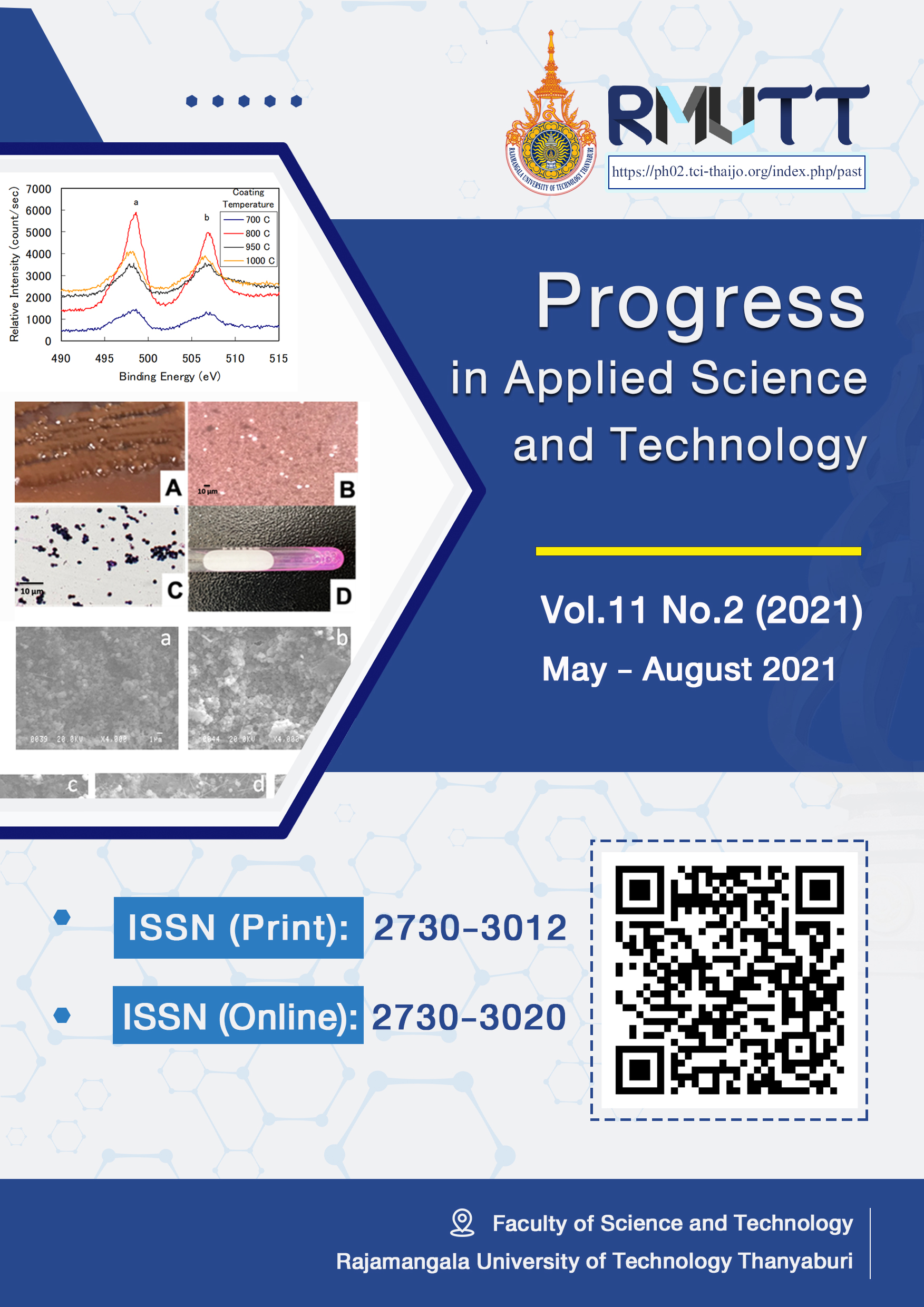Airborne Fungi in Buildings of Nakhon Ratchasima College
Main Article Content
Abstract
The indoor building environments have become a rising concern about indoor air quality (IAQ) impacting people health. This study examined viable airborne fungi from 13 sampling sites in various buildings of Nakhon Ratchasima College, Thailand, between July and August 2020. In order to investigate fungal diversity and amount of fungi contaminated in the indoor air and determine the correlation of the findings with environmental factors such as room temperature and relative humidity as well as the number of attendants. An open plate technique was used as a sampling method. Totally 160 samples of potato dextrose agar (PDA) plates were carried for 1 hour and twice a day. Standard plate count was used to quantify colony counts and fungal concentrations. Results showed the highest fungal concentration was found in the anatomy laboratory. The lowest fungal concentration was found in the office (eighth floor). Both sampling sites were classified by index of microbial air contamination (IMA) level as very good and good respectively. Eight fungal genera were identified. The dominant genera were Cladosporium and Aspergillus, followed by Penicillium, Fusarium, Alternaria, Rhizopus, Curvularia and Mucor. Statistical analysis based on Pearson’s correlation revealed the number of attendances had low negative correlation (r = -0.374) with the fungal concentrations (r = -0.374). Whereas relative humidity and room temperature had no correlation (r = -0.002 and -0.025 respectively). This study provides a profile of airborne fungi which benefit on indoor air quality assessments as fungal background data.
Article Details

This work is licensed under a Creative Commons Attribution-NonCommercial-NoDerivatives 4.0 International License.
References
Bongomin F, Gago S, Oladele RO, Denning DW. Global and multi-national prevalence of fungal diseases-estimate precision. J Fungi. 2017;3(57):1-29.
Meltzer EO, Blaiss MS, Naclerio RM, Stoloff SW, Derebery MJ, Nelson HS, Boyle JM, Wingertzahn MA. Burden of allergic rhinitis: allergies in America, Latin America, and Asia-Pacific adult surveys. Allergy Asthma Proc. 2012;33(Suppl1):113-41.
Hayleeyesus SF, Manaye AM. Microbiological quality of indoor air in university libraries. Asian Pac J Trop Biomed. 2014;4(Suppl1):312-7.
Mokhtari Amirmajdi M, Mokhtari Amirmajdi NA, Eftekharzadeh Mashhadi I, Jabari Azad F, Tavakol Afshari J, Shakeri MT. Alternaria in patients with allergic rhinitis. Iran J Allergy Asthma Immunol. 2011;10(3):221-6.
Kousha M, Tadi R, Soubani AO. Pulmonary aspergillosis: a clinical review. Eur Respir Rev. 2011;20(121):156-74.
Arundel AV, Sterling EM, Biggin JH, Sterling TD. Indirect health effects of relative humidity in indoor environments. Environ Health Perspect. 1986;65:351-361.
Tang W, Kuehn TH, Simcik M. Effects of Temperature, Humidity and Air Flow on Fungal Growth Rate on Loaded Ventilation Filters. J Occup Environ Hyg. 2015;12(8):525-37.
Basilico MLZ, Chiericatti C, Aringoli EE, Althaus RL, Basilico JC. Influence of environmental factors on airborne fungi in houses of Santa Fe City, Argentina. Sci Total Environ. 2007;376:143-50.
Bunnag C, Dhorranintra B, Plangpatanapanich ya A. A comparative study of the incidence of indoor and outdoor mold spores in Bangkok, Thailand. Ann Allergy. 1982;48(6):333-9.
Navi SS, Bandyopadhyay R, Hall AJ, Bramel-Cox PJ. A pictorial guide for the identification
of mold fungi on sorghum grain. Information Bulletin (59): International Crops Research Institute for Semi Arid Tropics: Patancheru: Andhra Pradesh: India; 1999.
Hedayati MT, Pasqualotto AC, Warn PA, Bowyer P, Denning DW. Aspergillus flavus: human pathogen, allergen and mycotoxin producer. Microbiology. 2007;153:1677-92.
Otasevic S, Miladinovic-Tasic N. Cladosporium spp. - cause of opportunistic mycoses. Acta Fac Med Naissensis. 2007;24(1):15-19.
Ponce-Caballero C, Gamboa-Marrufo M, Lopez-Pacheco´ M. Ceron-Palma I, Quintal-Franco C, Giacoman Vallejos G, Loria-Arcila J. Seasonal variation of airborne fungal propagules indoor and outdoor of domestic environments in Mérida, Mexico. Atmosfera. 2013;26(3):369-77.
Onmek N, Kongcharoen J, Singtong A, Penjumrus A, Junnoo S. Environmental factors and ventilation affect concentrations of microorganisms in hospital wards of southern Thailand. J Environ Public Health. 2020:7292198.
D'Amico A, Montagna MT, Caggiano G, De Giglio O, Rutigliano S, Lopuzzo M, Mascipinto S, Napoli C, Currà E, D'Alessandro D. Observational study on hospital building heritage and microbiological air quality in the orthopedic operating theater: the IM.PA.C.T. Project. Ann Ig. 2019, 31(5):482-95.
Pasquarella C, Pitzurra O, Savino A. The index of microbial air contamination. J Hosp Infect. 2000;46:241-56.
Pasanen AL, Kalliokoski P, Pasanen P. Laboratory studies on the relationship between fungal growth and atmospheric temperature and humidity. Environ Int. 1991;17:225-8.
Shelton B, Kirkland K, Flanders D, Morris G. Profiles of airborne fungi in buildings and outdoor environments in the United States. Appl Environ Microb. 2002;68:1743-53.
Wong LT, Chan WY, Mui KW, Hui PS. An assessment of airborne fungi exposure risk level in air-conditioned offices. Indoor Built Environ 2009;18:553-61.
Brickus LSR, Siqueira LFG, De Aquino Neto FR, Cardoso JN. Occurrence of airborne bacteria and fungi in Bayside Offices in Rio de Janeiro, Brazil. Indoor Built Environ. 1998;7: 270-5.
Asan A, Ilhan S, Sen B, Erkara IP, Filik C and Cabuk A. Airborne fungi and actinomycetes concentrations in the air of Eskisehir City (Turkey). Indoor Built Environ. 2004;13:63-74.
Taylor M, Gaskin S, Bentham R, Pisaniello D. Airborne fungal profiles in office buildings in metropolitan Adelaide, South Australia: Back ground levels, diversity and seasonal variation. Indoor Built Environ. 2013;0(0):1-10.
Horner WE. Managing building-related Aspergillus exposure. Med Mycol. 2006;44:33-8.






